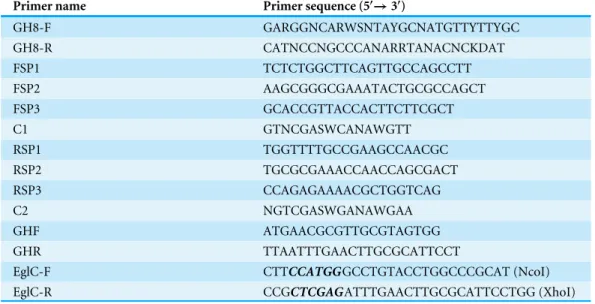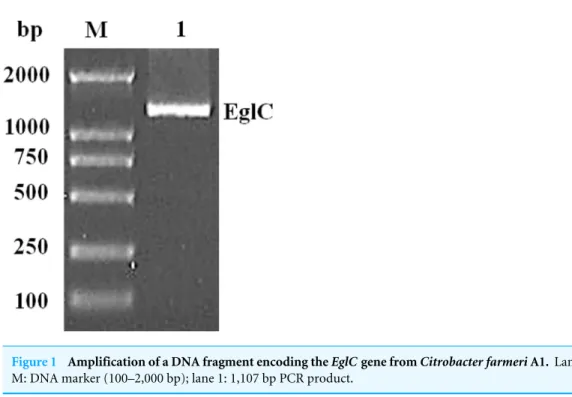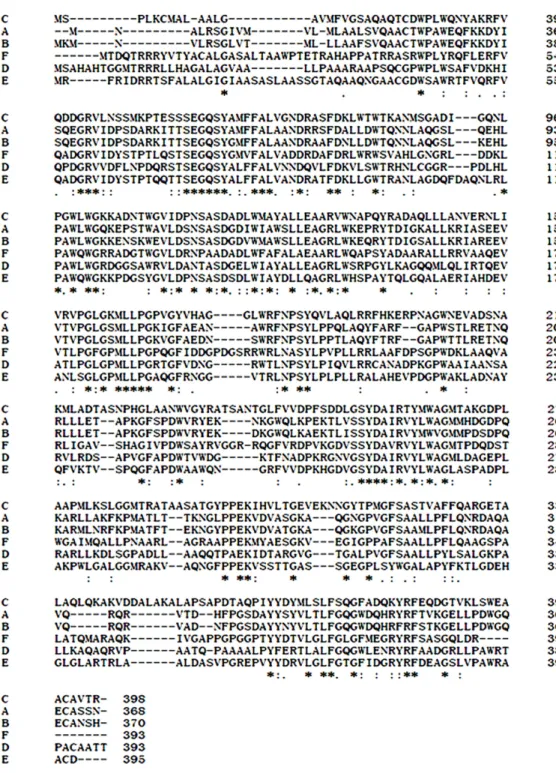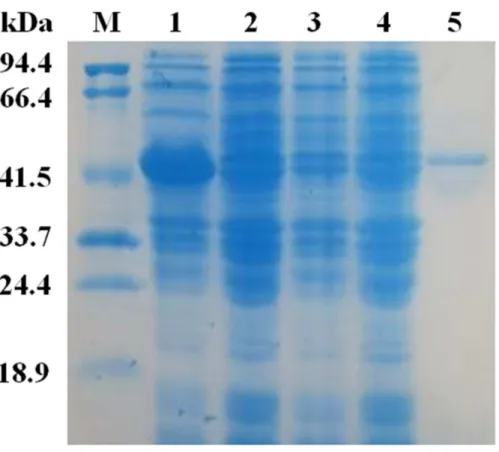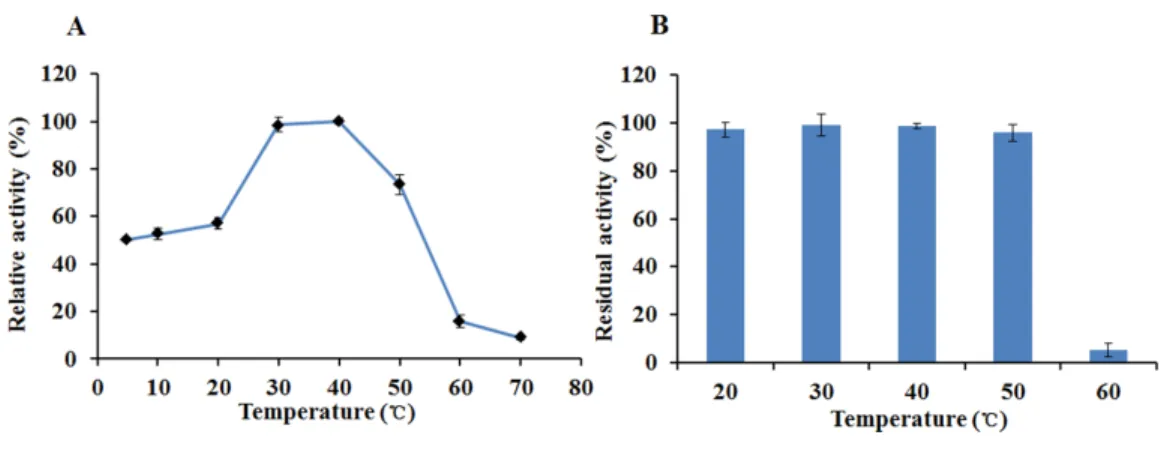Submitted22 June 2016
Accepted 12 October 2016
Published8 November 2016
Corresponding author
Tao Shao, taoshaolan@163.com
Academic editor
Pietro Gatti-Lafranconi
Additional Information and Declarations can be found on page 10
DOI10.7717/peerj.2679
Copyright
2016 Bai et al.
Distributed under
Creative Commons CC-BY 4.0
OPEN ACCESS
Cloning, expression and characterization
of a cold-adapted endo-1, 4-β-glucanase
from
Citrobacter farmeri
A1, a symbiotic
bacterium of
Reticulitermes labralis
Xi Bai1, Xianjun Yuan1, Aiyou Wen2, Junfeng Li1, Yunfeng Bai3and Tao Shao1 1Institute of Ensiling and Processing of Grass, Nanjing Agricultural University, Nanjing, China
2College of Animal Science, University of Science and Technology of Anhui, Fengyang, China 3Institute of Agricultural Resource and Environment, Jiangsu Academy of Agricultural Sciences,
Nanjing, China
ABSTRACT
Background. Many biotechnological and industrial applications can benefit from
cold-adapted EglCs through increased efficiency of catalytic processes at low temper-ature. In our previous study,Citrobacter farmeriA1 which was isolated from a wood-inhabiting termiteReticulitermes labraliscould secrete a cold-adapted EglC. However, its EglC was difficult to purify for enzymatic properties detection because of its low activity (0.8 U/ml). The objective of the present study was to clone and express the
C. farmeri EglC gene inEscherichia colito improve production level and determine the enzymatic properties of the recombinant enzyme.
Methods. TheEglCgene was cloned fromC. farmeriA1 by thermal asymmetric
inter-laced PCR.EglC was transformed into vector pET22b and functionally expressed in
E. coli. The recombination protein EglC22b was purified for properties detection.
Results. SDS-PAGE revealed that the molecular mass of the recombinant
endoglu-canase was approximately 42 kDa. The activity of theE. colipET22b-EglC crude ex-tract was 9.5 U/ml. Additionally, it was active at pH 6.5–8.0 with an optimum pH of 7.0. The recombinant enzyme had an optimal temperature of 30–40◦
C and exhibited >50% relative activity even at 5◦
C, whereas it lost approximately 90% of its activity after incubation at 60◦
C for 30 min. Its activity was enhanced by Co2+and Fe3+, but inhibited by Cd2+, Zn2+, Li+, Triton X-100, DMSO, acetonitrile, Tween 80, SDS, and EDTA.
Conclusion. These biochemical properties indicate that the recombinant enzyme is a
cold-adapted endoglucanase that can be used for various industrial applications.
SubjectsBiotechnology
Keywords Citrobacter farmeri, Endoglucanase, Cold-adapted, Expression,Escherichia coli, Properties
INTRODUCTION
Endo-β-1,4-glucanase (EglC, EC 3.2.1.4) is an important enzyme that hydrolyzes glycosidic linkages and releases oligosaccharides of different lengths. Some studies have suggested that EglC is more effective than exoglucanase and glucosidase for degrading cellulose (Yasir et al., 2013).
Numerous biotechnological and industrial applications can benefit from cold-adapted EglCs through increased efficiency of catalytic processes at low temperature (Kasana & Gulati, 2011). However, cold-adapted EglCs are generally not thermally stability and can easily be inactivated by elevated temperatures (Vester, Glaring & Stougaard, 2014) Such processes have the merits of saving production and energy costs, maintaining taste and other organoleptic characteristics and reducing the risk of contamination (Vester, Glaring & Stougaard, 2014).
For application in the biofuel industry, cold-adapted EglCs can produce ethanol from cellulosic material at low temperature (Cavicchioli et al., 2011). However, the biological conversion of cellulose to bioethanol is typically performed at relatively high temperatures (50–60◦
C), which can increase energy consumption and production costs (Cavicchioli et al., 2011;Tiwari et al., 2015) Cold-adapted EglCs can also be used in the degradation of polymer in pulp and paper processes, stonewashing and biopolishing of textiles, and in the food, silage and feed industries (Kasana & Gulati, 2011). Based on these applications, cold-adapted EglCs have attracted increased attention (Maharana & Ray, 2015;Gerday et al., 2000). However, few cold-adaptedβ-glucanases have been identified and cloned to date (Bhat et al., 2013;Cavicchioli et al., 2011)
EglC genes from some microorganisms have been cloned and expressed inEscherichia colifor secretion of endoglucanases (Kasana & Gulati, 2011). Termites have a rich variety of commensal microbes in their intestinal tracts that efficiently digest lignocellulose, and are thus considered as promising reservoirs of microbial symbionts and enzymes with high biotechnological potential (Brune, 2014). In our previous study,Citrobacter farmeriA1 that secreted cold-adapted EglC was isolated from the wood-inhabiting termite
Reticulitermes labralis (X Bai & T Shao, 2015, unpublished data). However the activity of this EglC was low (0.8 U/ml). The objective of the present work was to clone and express theEglCgene ofC. farmerito improve production level and determine the enzymatic properties of the recombinant enzyme.
MATERIALS AND METHODS
Plasmids, chemicals, and culture medium
C. farmeriA1 that secreted cold-adapted EglC was isolated fromR. labralisand stored in our laboratory. The plasmid pMD20-T vector (TaKaRa, Dalian, China) andE. coliDH5α
were used for gene cloning, whereas the pET22b vector (Novagen, Madison, WI) and
Table 1 Primers used in this study.
Primer name Primer sequence (5′
→3′)
GH8-F GARGGNCARWSNTAYGCNATGTTYTTYGC GH8-R CATNCCNGCCCANARRTANACNCKDAT FSP1 TCTCTGGCTTCAGTTGCCAGCCTT FSP2 AAGCGGGCGAAATACTGCGCCAGCT FSP3 GCACCGTTACCACTTCTTCGCT C1 GTNCGASWCANAWGTT RSP1 TGGTTTTGCCGAAGCCAACGC RSP2 TGCGCGAAACCAACCAGCGACT RSP3 CCAGAGAAAACGCTGGTCAG C2 NGTCGASWGANAWGAA GHF ATGAACGCGTTGCGTAGTGG GHR TTAATTTGAACTTGCGCATTCCT
EglC-F CTTCCATGGGCCTGTACCTGGCCCGCAT (NcoI)
EglC-R CCGCTCGAGATTTGAACTTGCGCATTCCTGG (XhoI)
EglC gene cloning
Genomic DNA ofC farmeriA1 was isolated using the TIANamp Bacteria DNA Kit (Tiangen, Beijing, China). The core region of theEglC gene was amplified using the degenerate primers GH8-F and GH8-R (Table 1), which were designed based on two conserved blocks, EGQSY[A/G][M/L]FFAL and DAIRVY[L/M]WAG[M/L], of the gly-coside hydrolase family 8 (GH8) bacterial endoglucanases. Touchdown PCR conditions were as follows: an initial denaturation step of 5 min at 95◦
C and 15 cycles of 30 s at 94◦
C, 30 s at 70◦
C, and 20 s at 72◦
C, followed by 30 cycles of 30 s at 94◦
C, 30 s at 55◦
C, and 40 s at 72◦
C, and a final elongation step of 10 min at 72◦
C. Amplified DNAs of the appropriate size were purified and ligated into the pMD20-T vector, and confirmed by DNA sequencing (Genscript Corporation, Nanjing, China).
Full-lengthEglCwas amplified by thermal asymmetric interlaced PCR (TAIL-PCR) using nested insertion-specific primers designed based on the conserved domain. The 5′
-flanking genomic sequences were amplified using FP-specific primers (FSP1, FSP2, and FSP3;Table 1) and the random degenerate primer C1, whereas the 3′
-flanking genomic sequences were amplified with RP-specific primers (RSP1, RSP2, and RSP3;Table 1) and the random degenerate primer C2 using the TaKaRa Genome Walking Kit (TaKaRa, Dalian, China). The TAIL-PCR products were ligated into the pMD20-T vector and transformed intoE. coliDH5αfor DNA sequencing. Then, the 5′
- and 3′
-flanking regions were assembled with the core sequence.
Based on the assembled sequence, the GHF and GHR primers (Table 1) were used to amplify the full length of theEglCgene. The PCR program included an initial step of 6 min at 95◦
C, a second step of 35 cycles including 35 s at 95◦
C, 1 min at 60◦
C and 1 min at 72◦
C, and a final step of 8 min at 72◦
Construction and transformation of the recombinant expression vectors
For expression ofEglC inE. coli, the mature protein-coding sequences (signal peptide excluded) were amplified by PCR from genomic DNA ofC. farmeriA1. The PCR primers were EglC-F and EglC-R containingNcoI andXhoI sites (Table 1). The PCR program included an initial step of 6 min at 95◦
C, a second step of 35 cycles including 35 s at 95◦
C, 1 min at 58◦
C and 1 min at 72◦
C, and a final step of 8 min at 72◦
C The purified PCR products were ligated into the pMD20-T plasmid. The vector pMD20-EglC was digested withNcoI andXhoI, and then the purifiedEglCgene was cloned to the pET22b vector. The resulting plasmid pET22b-EglC, was transformed intoE. coliBL21 and plated on LB agar containing 100µg ml−1ampicillin to select positive transformants. The
positive clones were checked by colony PCR using EglC-F and EglC-R primers (Table 1). The plasmid pET22b-EglC was sequenced by Genscript Corporation (China).
Expression of theEglC gene inE. coli and purification of the recombinant protein
The recombinantE. colipET22b-EglC was cultured at 37◦
C in LB medium with ampi-cillin. When the culture density reached an optical density of approximately 0.5 at 600 nm, isopropyl-b-D-1-thiogalactopyranoside (IPTG) was added into the medium to a final concentration of 1 mM to induce endoglucanase expression. After 4 h, cultured cells were collected by centrifugation at 10,000×g for 6 min at 4◦C, resuspended in ice-cold
buffer (Na2HPO4-citric acid; pH 7), and disrupted by sonication. Proteins were obtained
by centrifugation and purified using a Ni2+
affinity chromatography column (CWBIO, China). Expressed proteins were detected by sodium dodecyl sulfate-polyacrylamide gel electrophoresis (SDS-PAGE), and their concentration was determined using a Micro BCA protein assay kit (Jiancheng, Nanjing, China).
Detection of enzymatic activities
The activity of Eglc22b was determined using the 3,5-dinitrosalicylic (DNS) method as described byFu et al. (2010). Sodium-carboxymethyl cellulose (CMC-Na) was used as a substrate at a concentration of 1.0% (w/v). The standard reaction mixture, containing 1 ml of appropriately diluted enzyme and 1 ml of CMC-Na buffer (pH 7), was incubated at 40◦
C for 30 min. The reaction was terminated by addition of 3 ml of DNS to the mixture and 5 min of boiling. The release of reducing sugars was measured at 540 nm by using a spectrophotometer (Shanghai Precision & Scientific Instrument Co., Shanghai, China). One glucanase unit was defined as the amount of enzyme required to release 1µmol of
glucose per minute at the assay temperature.
Biochemical characteristics of EglC22b
The optimum pH for the activity of EglC22b was determined at 40◦
C for 30 min in Na2HPO4-citric acid buffer (pH 3.5–7) and sodium phosphate buffer (pH 8.0). To
determine the pH stability, EglC22b was incubated at 40◦
The optimal temperature for the activity of EglC22b was determined in Na2HPO4
-citric acid buffer (pH 7.0) at 10◦
C to 70◦
C (10◦
C interval) for 30 min. To determine the thermal stability, EglC22b was incubated at 20, 30, 40, 50, and 60◦
C for 30 min each, and the residual enzyme activity was measured at optimal pH and temperature using the DNS method as described previously.
The effects of different metal ions and chemical reagents on the activity of EglC22b were assessed by incubating the enzyme at 40◦
C for 30 min in a standard reaction mixture of Na2HPO4-citric acid buffer (pH 7.0) containing CoCl2(2 mM), CdCl2(2
mM), ZnCl2(2 mM), FeCl3(2 mM), Li2SO4(2 mM), Triton X-100 (10%), dimethyl
sulfoxide (DMSO, 20%), acetonitrile (20%), Tween 80 (20%), SDS (0.4%), and ethylene-diamine-tetraacetic acid (EDTA, 20 mM). An assay system without the added metal ions was used as a control, and the enzyme activity was measured using the DNS method as described previously.
Statistical analysis
All measurements of the present study were carried out in duplicate. Data were analyzed by Microsoft Excel 2010. Data were presented as means with standard deviation (SD).
RESULTS
Cloning and sequencing of EglC
An approximately 600-bp core region ofEglCwas amplified by touchdown PCR fromC. farmeriA1. Based on the sequence of theEglC core region, TAIL-PCR was used to amplify the flanking sequences of the DNA fragment. Finally, a 1,107 bp fragment was obtained fromC farmeriA1 (Fig. 1). The open reading frame was predicted to encode a protein of 368 amino acids with a theoretical molecular mass of 39.1 kDa. Sequence analysis revealed a signal peptide with a length of 21 amino acids at the N-terminal of the enzyme. A BLAST search was used to predict the mature EglC ofC. farmeri, revealing that the mature EglC belongs to glycoside hydrolase family 8 (Fig. 2). Additionally, the deduced EglC had 86.4%, 43.4%, 44.7%, 39.7%, and 44.3% amino acid sequence identity with endo-β-1,4-glucanases fromE. coliCFT073,Burkholderiasp. CCGE1002,Cupriavidus taiwanensis,Pseudomonas fluorescensSBW25, andXanthomonas campestrispv.vesicatoria
strain 85-10, respectively (Fig. 3). The nucleotide sequence ofEglC was deposited in the GenBank database (GenBank accession no.KT313000).
Expression and purification of EglC22b
The matureEglCgene without the signal peptide was cloned into the pET22b vector for expression. SDS-PAGE revealed that the apparent molecular mass of EglC22b was approximately 42 kDa (Fig. 4). This band was not present in non-transformed strains. The activity of theE. colipET22b-EglC crude extract was 9.5 U/ml.
The crude EglC22b was purified using Ni2+
Figure 1 Amplification of a DNA fragment encoding theEglCgene fromCitrobacter farmeriA1.Lane M: DNA marker (100–2,000 bp); lane 1: 1,107 bp PCR product.
Figure 2 Conserved domains prediction of the EglC.Conserved domains prediction was performed by NCBI CD-search software (https://www.ncbi.nlm.nih.gov/Structure/cdd/wrpsb.cgi).
Effects of pH and temperature on the activity of EglC22b
The activity and stability of EglC22b were assayed in CMC-Na at different pH values and temperatures. EglC22b showed optimal activity at pH 7.0 and exhibited >94% and >85% relative activity at pH 6.5 and 8.0 (Fig. 5A). EglC22b was highly stable at pH 3.5–7.5 and retained >70 % residual activity after 30 min of incubation in these buffers (Fig. 5B).
The recombinant enzyme had an optimal temperature of 30–40◦
C and exhibited >50% relative activity even at 5◦
C (Fig. 6A). The activity of EglC22b was lost rapidly at temperatures higher than 60◦
C (Fig. 6A). The thermotolerance analysis showed that approximately 90% of enzymatic activity was lost after 30 min of incubation at 60◦
C (Fig. 6B)
Effects of chemical reagents and metal ions on the activity of EglC22b
The effects of various chemical reagents and metal ions on the activity of EglC22b were tested (Fig. 7). The presence of Cd2+
, Zn2+
, Li+
, Triton X-100, DMSO, acetonitrile, Tween 80, EDTA, and SDS inhibited the activity of EglC22b. However, the presence of Co2+
and Fe3+
Figure 3 Comparison of EglC protein sequences from different microorganisms.(A)Citrobacter farmeriA1 (This study); (B)Escherichia coliCFT073 (GenBank accession no.AAN82779); (C)
Pseudomonas fluorescensSBW25 (GenBank accession no.WP_012721724.1); (D)Xanthomonas campestrispv.vesicatoria str.85-10 (GenBank accession no.WP_011348564.1); (E)Burkholderia sp.CCGE1002 (GenBank accession no.WP_012355143.1); (F)Cupriavidus taiwanensis(GenBank accession no.WP_012355143.1). Multiple sequence alignment was performed by Clustal Omega software (http://www.ebi.ac.uk/Tools/msa/clustalo/).Asterisksshow residues in the column are identical in all sequences in the alignment.Dotsshow semi-conserved substitutions observed in the alignment.Colons
Figure 4 SDS-PAG analysis of the recombinant EglC22b stained with Coomassie blue.Lane M: protein MW marker (18.9–94.4 kDa); Lane 1: IPTG-inducedE. colipET22b-EglC; Lane 2:E. colipET22b-EglC; Lane 3: IPTG-inducedE. colipET22b; Lane 4:E. colipET22b; Lane 5: purified EglC22b.
Figure 5 The pH properties of EglC22b.(A) Effect of pH on the activity of EglC22b; (B) The pH stabil-ity of EglC22b. The EglC22b activstabil-ity which was detected at optimal pH and temperature was regarded as 100%. All measurements of the present study were carried out in duplicate. Data were presented as means with standard deviation (SD).
DISCUSSION
Our previous study showed thatC. farmeriA1 from the gastrointestinal tract ofR. labralis
Figure 6 The temperature properties of EglC22b.(A) Effect of temperature on the activity of EglC22b; (B) The temperature stability of EglC22b. The EglC22b activity which was detected at optimal pH and temperature was regarded as 100%. All measurements of the present study were carried out in duplicate. Data were presented as means with standard deviation (SD).
Figure 7 Effects of chemical reagents and metal ions on the activity of EglC22b.The EglC22b activity which was detected at optimal pH and temperature was regarded as 100% (Control). All measurements of the present study were carried out in duplicate. Data were presented as means with standard deviation (SD).
including fungus, bacteria, and actinomycetes have been studied, no endoglucanase fromC. farmerihas been characterized to date (Shelomi et al., 2014;Asgher, Ahmad & Iqbal, 2013). In the present study, a cold-adapted endoglucanase was cloned fromC. farmeriA1 and expressed inE. coli. The recombinant enzyme was purified to determine its biochemical properties.
mature protein. For characterization, the mature protein of EglC was expressed inE. coli. SDS-PAGE revealed that the molecular weight (MW) of EglC22b was approximately 42 kDa, which was similar to the theoretical MW of 39.1 kDa.
EglC22b was characterized as a neutral enzyme (i.e., active at neutral pH). The recom-binant EglC22b was active at pH 6.5–8.0 with optimum activity at pH 7.0, which was similar to the characteristics ofC. farmeriEglC and the endoglucanase (Umcel9B) isolated from compost soil microorganisms (Pang et al., 2009). The present results indicate that EglC22b was highly stable at pH 3.5–6.5 for 30 min. Similar pH stability was also observed in the EG5C endoglucanase fromPaenibacillussp. IHB B 3084 (Dhar et al., 2015).
Although many endoglucanases have been studied, only few cold-adapted enzymes have been reported (Fu et al., 2010;Ueda et al., 2014). It is known that cold-adapted enzymes show relatively high activity at low temperatures and have a low optimal temperature and poor thermal stability (Dhar et al., 2015). EglC22b showed optimal activity at 30–40◦
C and more than 50% maximal activity at 10◦
C. It also had relatively poor thermal stability, where approximately 90% of its activity was lost after incubation at 60◦
C for 30 min. These temperature properties suggest that EglC22b has typical characteristics of cold-active endoglucanases, which was identical to the EglC ofC. farmeri
A1. Similar results were also previously observed for endoglucanase and cellulase from
Paenibacillussp. IHB B 3084 (a psychrophilic deep-sea bacterium) andEisenia fetida
(Dhar et al., 2015;Yang & Dang, 2011;Zeng, Xiong & Wen, 2006;Ueda et al., 2014). In contrast, the mesophilic and thermmophilus endoglucanases were previously shown to rapidly lose activity at temperatures below 20◦
C (Bischoff, Liu & Hughes, 2007;Li et al., 2011)
Several reports have indicated that Co2+
can enhance the activity of endoglucanases fromE. coliRosetta 2 andAspergillus niger (Rawat et al., 2015;Martin et al., 2014). In the present study, the activity of EglC22b was also increased by the presence of Co2+
. Furthermore, SDS and DMSO were found to almost totally inhibit the activity of EglC22b (<10%), which was in agreement with a previous study (Dhar et al., 2015;Manavalan et al., 2015).
CONCLUSION
AnEglCgene was cloned fromC. farmeriA1 and then expressed inE. coli. Biochemical characteristics of EglC22b indicated that it was a low-temperature-active endoglucanase. Cold-adapted endo-1,4-β-glucanases can protect thermolabile substrates, reduce energy consumption, and minimize the rate of nonspecific chemical reactions. Further studies in our laboratory will focus on its applications in the feed, food and silage industry
ADDITIONAL INFORMATION AND DECLARATIONS
Funding
Sciences Program (STS) ‘‘Grassland agricultural system construction and industrialization demonstration of typical village (Jina village) in Tibet’’ (KFJ-EW-STS-071), and the National Spark Plan Project ‘‘Integration and demonstration of planting high quality forage grass and breeding cows healthily technology’’ (2013GA840003). The funders had no role in study design, data collection and analysis, decision to publish, or preparation of the manuscript.
Grant Disclosures
The following grant information was disclosed by the authors: Independent Innovation of Agricultural Sciences: CX(15)1003.
Network and Technology Served of Chinese Academy of Sciences Program (STS): KFJ-EW-STS-071.
National Spark Plan Project: 2013GA840003.
Competing Interests
The authors declare there are no competing interests.
Author Contributions
• Xi Bai conceived and designed the experiments, performed the experiments, analyzed
the data, contributed reagents/materials/analysis tools, wrote the paper, prepared figures and/or tables, reviewed drafts of the paper.
• Xianjun Yuan conceived and designed the experiments. • Aiyou Wen and Yunfeng Bai analyzed the data.
• Junfeng Li performed the experiments.
• Tao Shao conceived and designed the experiments, wrote the paper, reviewed drafts of
the paper.
DNA Deposition
The following information was supplied regarding the deposition of DNA sequences: GenBank accession numbers:KT313000.
Data Availability
The following information was supplied regarding data availability: The raw data has been supplied as aSupplementary File.
Supplemental Information
Supplemental information for this article can be found online athttp://dx.doi.org/10. 7717/peerj.2679#supplemental-information.
REFERENCES
Asgher M, Ahmad Z, Iqbal HMN. 2013.Alkali and enzymatic delignification of
sugar-cane bagasse to expose cellulose polymers for saccharification and bio-ethanol pro-duction.Industrial Crops and Products44:488–495
Bhat A, Riyaz-Ul-Hassan S, Ahmad N, Srivastava N, Johri S. 2013.Isolation of cold-active, acidic endocellulase from Ladakh soil by functional metagenomics.
Extremophiles17:229–239DOI 10.1007/s00792-012-0510-8.
Bischoff KM, Liu S, Hughes SR. 2007.Cloning and characterization of a recombinant
family 5 endoglucanase fromBacillus licheniformisstrain B-41361.Process Biochem-istry 42:1150–1154DOI 10.1016/j.procbio.2007.05.001.
Brune A. 2014.Symbiotic digestion of lignocellulose in termite guts.Nature Reviews
Microbiology12:168–180DOI 10.1038/nrmicro3182.
Cavicchioli R, Charlton T, Ertan H, Omar SM, Siddiqui KS, Williams TJ. 2011.
Biotechnological uses of enzymes from psychrophiles.Microbial Biotechnology
4:449–460DOI 10.1111/j.1751-7915.2011.00258.x.
Dhar H, Kasana RC, Dutt S, Gulati A. 2015.Cloning and expression of low temperature
active endoglucanase EG5C fromPaenibacillussp. IHB B 3084.International Journal of Biological Macromolecules81:259–266 DOI 10.1016/j.ijbiomac.2015.07.060.
Fu X, Liu P, Lin L, Hong Y, Huang X, Meng X, Liu Z. 2010.A novel endoglucanase
(Cel9P) from a marine bacteriumPaenibacillussp. BME-14.Applied Biochemistry and Biotechnology160:1627–1636DOI 10.1007/s12010-009-8648-2.
Gerday C, Aittaleb M, Bentahir M, Chessa JP, Claverie P, Collins T, D’Amico S.
2000.Cold-adapted enzymes: from fundamentals to biotechnology.Trends in
Biotechnology18:103–107DOI 10.1016/S0167-7799(99)01413-4.
Kasana RC, Gulati A. 2011.Cellulases from psychrophilic microorganisms: a review.
Journal of Basic Microbiology51:572–579DOI 10.1002/jobm.201000385.
Li J, Tang C, Shi H, Wu M. 2011.Cloning and optimized expression of a neutral
en-doglucanase gene (ncel5A) fromVolvariella volvaceaWX32 inPichia pastoris.Journal of Bioscience and Bioengineering 111:537–540DOI 10.1016/j.jbiosc.2011.01.002.
Limayem A, Ricke SC. 2012.Lignocellulosic biomass for bioethanol production: current
perspectives, potential issues and future prospects.Progress in Energy and Combustion Science38:449–467DOI 10.1016/j.pecs.2012.03.002.
Maharana AK, Ray P. 2015.Optimization and characterization of cold-active
endoglu-canase produced byAspergillus terreusstrain AKM-F3 grown on sugarcane bagasse.
Turkish Journal of Biology39:175–185DOI 10.3906/biy-1408-22.
Manavalan T, Manavalan A, Thangavelu KP, Heese K. 2015.Characterization of a novel
endoglucanase fromGanoderma lucidum.Journal of Basic Microbiology55:761–771
DOI 10.1002/jobm.201400808.
Martin M, Biver S, Steels S, Barbeyron T, Jam M, Portetelle D, Michel G, Vanden-bol M. 2014.Identification and characterization of a halotolerant, cold-active marine endo-β-1, 4-glucanase by using functional metagenomics of seaweed-associated microbiota.Applied and Environmental Microbiology 80:4958–4967
DOI 10.1128/AEM.01194-14.
Ogura J, Toyoda A, Kurosawa T, Chong AL, Chohnan S, Masaki T. 2006.Purification,
characterization, and gene analysis of cellulase (Cel8A) fromLysobactersp. IB-9374.
Ozioko PC, Eze SOO, Chilaka FC. 2013.Partial purification and characterization of cellulases from digestive tracts of the African giant snail (Achatina achatina).Turkish Journal of Biology 37:199–205.
Pang H, Zhang P, Duan CJ, Mo XC, Tang JL, Feng JX. 2009.Identification of
cellulase genes from the metagenomes of compost soils and functional char-acterization of one novel endoglucanase.Current Microbiology58:404–408
DOI 10.1007/s00284-008-9346-y.
Rawat R, Kumar S, Chadha BS, Kumar D, Oberoi HS. 2015.An acidothermophilic
functionally active novel GH12 family endoglucanase fromAspergillus nigerHO: purification, characterization and molecular interaction studies.Antonie Van Leeuwenhoek107:103–117DOI 10.1007/s10482-014-0308-z.
Shelomi M, Jasper WC, Atallah J, Kimsey LS, Johnson BR. 2014.Differential expression
of endogenous plant cell wall degrading enzyme genes in the stick insect (Phasma-todea) midgut.BMC Genomics15:1DOI 10.1186/1471-2164-15-917.
Tiwari R, Nain PKS, Singh S, Adak A, Saritha M, Rana S, Sharma A, Nain L. 2015.Cold
active holocellulase cocktail fromAspergillus nigerSH3: process optimization for production and biomass hydrolysis.Journal of The Taiwan institute of Chemical Engineers56:57–66DOI 10.1016/j.jtice.2015.04.026.
Ueda M, Ito A, Nakazawa M, Miyatake K, Sakaguchi M, Inouye K. 2014.Cloning and
expression of the cold-adapted endo-1, 4-β-glucanase gene fromEisenia fetida.
Carbohydrate Polymers101:511–516DOI 10.1016/j.carbpol.2013.09.057.
Vester J, Glaring MA, Stougaard P. 2014.Discovery of novel enzymes with industrial
po-tential from a cold and alkaline environment by a combination of functional metage-nomics and culturing.Microbial Cell Factories13:72DOI 10.1186/1475-2859-13-72.
Yang J, Dang H. 2011.Cloning and characterization of a novel cold-active
en-doglucanase establishing a new subfamily of glycosyl hydrolase family 5 from a psychrophilic deep-sea bacterium.FEMS Microbiology Letters325:71–76
DOI 10.1111/j.1574-6968.2011.02413.x.
Yasir M, Khan H, Azam SS, Telke A, Kim SW, Chung YR. 2013.Cloning and functional
characterization of endo-β-1, 4-glucanase gene from metagenomic library of
vermicompost.Journal of Microbiology51:329–335DOI 10.1007/s12275-013-2697-5.
Zeng R, Xiong P, Wen J. 2006.Characterization and gene cloning of a cold-active
cellulase from a deep-sea psychrotrophic bacteriumPseudoalteromonassp. DY3.
